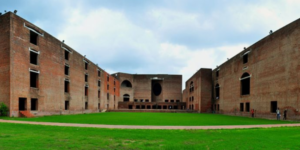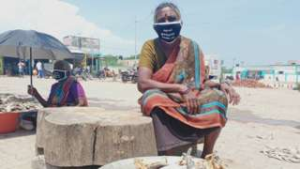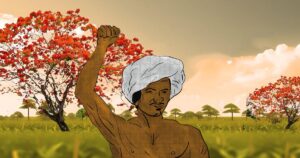COVID – 19 as a pandemic has been perceived in India as the dark side of globalization. It was received with great surprise and anxiety. People are overwhelmed by fear due to its deadly universality and baffling novelty. Politically, there has been furthering of centralization of political power, communication break-down between the ruling alliance and the opposition parties, and weakening of the federal structure of the Indian nation-state. Economically, it has proved to be quite disruptive which has magnified the pre-existing economic risks.[1] The growth rate came down to 3.1% and the unemployment rate rose from 6.7% on 15 March to 26% on 19 April, 2020. It is estimated that at least 140 million have lost employment. The informal sector, daily wage earners and farmers have been put to maximum risk.
This is a short essay about the impact of COVID-19 in India. It covers a period of 18 weeks – between 13th March,’20 to 27 July, 2020. It is organised in three sections: i. The Indian response; ii. Four dimensions of the COVID-19 crisis; and iii. Lessons of the COVID-19 crisis.
The Indian Response to COVID-19
India responded to the arrival of COVID-19 as if the nation was facing a disastrous war. All public facilities excluding hospitals and police stations were closed indefinitely. There was an end to all community activities including worshipping, marketing, schooling, sports and entertainment. There were frequent media appearances by prime minister and other ministers to assure the citizens about the preparedness of the government and the nation to overcome the crisis caused by COVID-19. The corporate houses made large donations to the Prime Minister Care Fund as well as retrenched employees from their establishments. Indian farmers, workers in organised and un-organised sector, micro-small-medium entrepreneurs and media offered full cooperation to the Indian state in controlling the pandemic.
The Indian state took steps to meet the challenge of this uninvited virus by invoking the National Disaster Management Act. It included a) augmentation of health care facilities, b) food security, c) sector-wise incentives, and d) extension of deadline about taxes. It came out with a package of $280 billion on 12th May,’20 (which amounted to 10% of the Indian G. D. P.) to provide support to all stakeholders of the Indian economy as shock-absorber. It also began distancing from continuing of economic globalization by change in the provisions of Foreign Direct Investment (F. D. I.) to save the Indian companies from the global competitors including the Chinese companies through protectionism. Emphasising ‘self-reliance’ (‘Atmanirbhar Bharat Abhiyan’) and signifying ‘local’ became the new priorities since introduction of the lockdown. These initiatives have met with scepticism from various quarters.[2] In any case, India has entered a new stage while engaging with COVID-19 pandemic.
It has become known that scientific community began warning about the seriousness of COVID – 19 from early January, 2020 after the Chinese authorities named it on 7th January, ‘20. But the Director General of World Health Organization Tedros Adhanom Ghebreyesus declared it as a pandemic only on 11 March,’20 after 118,000 cases were reported in 114 countries with 4291 deaths. The first death in India due to this new global disease in India on 13th March in Karnataka.
The Indian government waited for two more weeks to get into effective action about it when Prime Minister Narendra Modi announced a 21 days lock-down on national TV on 25th March. According to Economic Times, in a bold decision, Prime Minister Narendra Modi announced a complete lockdown in India. The lockdown will begin at 12 pm tonight/Tuesday. Modi said social distancing is the only way to kill the virus and if we don’t stay away for 21 days, the country would go back 21 years.’[3] It was followed by 20 major steps in the next 20 days with the promise of winning the war against Corona in 21 days. They included free provision of food items and cooking gas cylinders to daily wage earners, financial support to farmers, tax relief to micro, small and medium scale enterprises, large infusion of economic incentives to manufacturing and service sector and a partnership with corporate houses and NGOs to come forward in providing health care, medicines and daily amenities to the vulnerable masses. Unfortunately, there was no success in ‘flattening the curve’ even after lockdown for more than four months.
According to the official sources, India has become the third most affected country after the USA and Brazil in the world. Globally, there were 16.3 million confirmed cases of COVID-19 with 9.41 million recovered and 649,000 deaths whereas there were 1.4 million confirmed cases with 918,000 persons recovered and 32,771 deaths reported in India on till 27th July, 2020.[4] There are two significant features of COVID-19 in India so far. First of all, the death rate in India is found to be 20.4 persons per million whereas the global average has been 77 per million. Secondly, the spread of it in India has been quite uneven with more than 50% cases confined to just four states – Maharashtra (347,502), Tamil Nadu (192,964), Delhi (127,364) and Karnataka (80,813) and thirty cities.
Four Dimensions of COVID-19 Crisis
It is important to acknowledge that it was a case of gross under-estimation which has caused several grave problems. There are at least four dimension of the crisis due to COVID 19 in India – i. India is facing the Corona pandemic with a severely stressed health care system. The health workers from doctors and nurses to para-medical staff were given new status of ‘Corona Warriors’ to incentivise them to perform their duties diligently in a highly risky setting. But sandwiched between low investment in public health care infra-structure in small towns and rural areas and intense commercialization of health services in metropolitan centres, majority of the population is staring at unpredictable future with fear and anxiety.
It is confronting a political crisis where there is great thrust for centralization in a federalizing system of governance coupled with increasing curbs on rights of the working class and arrests of citizen activists. Moreover, the state apparatus has to enforce indefinite ‘lock down’ as well as maintain availability of doctors and health care workers to manage a fatal viral disease. It called for nation-wide programmes of praising the ‘Corona Warriors’ by lighting candles and lamps, clapping and other ways of expression of gratitude including showering of flowers. It has to ensure supply of essential commodities and medicines at low costs in a setting of systemic leakages and global scarcity. It is also responsible for preventing community spread of the disease by policing large scale movement of a very a large number of working people who cannot afford to obey the advice of ‘stay home to stay safe’.
There is deepening of the economic crisis related with the pre-existing global recession. Long lockdown in response to the spread of COVID-19 has sudden collapse of the livelihood system in urban areas. The government came forward with schemes of food security and cash transfer for the poorer sections. The lockout related livelihood-crisis made millions of workers from the un-organised sector rush to their villages and get work under the Mahatma Gandhi National Rural Employment Guarantee Scheme (MNREGA) where the daily wages were enhanced from Rs. 182/- per day to Rs. 202/- per day. The lockdown impacted demands negatively. It added new problems in the already sluggish market system. The economic crisis got compounded by termination of the national and global networks of transport of people and commodities.
India is experiencing growing socio-cultural crisis caused by over-stretched family systems and unexpected stresses upon the community networks. The melt down of the citizenship entitlements has to be repaired with new schemes at the micro-level. The incapacity of the rural-urban nexus to absorb the ‘migrant workers’ in its fold has forced many working people to opt for ‘reverse migration’!
Togetherness of a) health hazards, b) livelihood crisis, and c) disruption of community networks has taken the Indian state and political community by surprise. It was manifested in responses to the migrant exodus. The central government ignored the need of supporting decentralised local-specific interventions. The non-NDA state governments resisted encroachment upon their domain by various agencies of the union government. The elected representatives and major political parties remained clueless spectators of this unprecedented Constitutional chaos. It caused double failures – the central government kept on changing norms of lock-down, and the state governments became callous about the provisions of implementing the lockdown and urgently preparing for the testing, treatment and tracking of the COVID-19 victims. Several state governments went further by refusing to allow ‘return’ of ‘migrant labourers’ from various states who have been source of large amount of ‘remittances’ for years.
There was prioritization of the needs and interests of the upper and middle classes in the initial moves of the government system. The government agencies were asking all people to maintain ‘social distancing’ by ‘staying home’ and maintaining cleanliness by frequent hand washing with soap and water and use of sanitizers. It made sense to the better off sections who had enough savings to be able to ‘stay at home’ in their well equipped homes in ‘gated communities’.
But it ignored the stark realities of the working and living conditions of majority of working urban population who were living with very limited incomes in rented rooms, shared toilets with limited supply of water and electricity. After a few days of poor enforcement of sudden lockdown, increasing mis-match between the central steps and state government initiatives, and failing support systems like free meals, testing at the hospitals, temporary shelters in schools etc. there was rushing out of the entire class of low-income men and women from metropolitan India. They belonged to ‘unorganised sector’ with no organisational strength or political support. They were strangely called ‘migrant workers’. There exodus was conveniently termed as ‘going home’. There transport needs were ignored as the train movements and bus services were not available for several weeks due to ‘lockdown’.
Millions of working men and women became strangers in their own cities and country due to explicit limits of political citizenship and devaluation of economic and social citizenship. Women of the daily wage earner households became more burdened with intensification of household management in a time of no income and scarcity and shortages essential items. There were reports of increase in domestic violence. Children and old age persons experienced new issues and problems in ‘the lockdown period’. A variety of civil society groups came forward to provide social support. There were also spontaneous initiatives by citizen volunteers in response to the calls for help from distressed people – ranging from food items to medicines and blood donation.
It invited expression of resentment by all central trade unions, irrespective of the ideological divides, about the relief package offered by the government to the entrepreneurs and corporate sector. Because there was little relief for the millions of working men and women but several concessions for the entrepreneurial classes including exemption of Indian and foreign enterprises from labour laws like Industrial Disputes Act, Act on Occupational Safety, Trade Union Act, and Contract Labour Act. The working classes are openly found to be protesting about fiddling with Factory Act of 1948 to pave way for 12 hours/ six days of work, Employees Provident Fund, suspension of right of collective bargaining, payment of proper wages, safety of workers, and social security. They are apprehensive that in its drive to promote better global ranking in terms of ‘ease of doing business’, there is continuous neglect of maintaining a congenial environment for the working men and women.
Lessons of COVID-19
COVID-19 pandemic in India has become an eye-opener about not only the peripheral nature of market mediated economic globalization but also the mechanical character of the Republic of India. There was no respect shown to the citizenship related entitlements of the low wage earning Indian men and women. They became ‘economic refugees’ who went through painful oscillation between their ‘urban sites of livelihood’ and ‘rural spaces of kinship’ in search of secure shelter from twin troubles of COVID-19 and loss of livelihood. The constitutional commitment of maintaining a system of people oriented governance was found to be an imaginary claim. An external virus has created crisis of confidence of the under-privileged sections of Indian people about the durability of the architecture of Indian nationality and democratic government.
Thus, the challenge of Corona crisis has created a new national awareness about the prevalence of several gaps and shortcomings in the prevalent process of democratic nation-building through LPG paradigm (Liberalization-Privatization-Globalization) since 1990s. They have been underlined by the tragic exodus of millions of workers from their sites of livelihood. There is need of course-correction as there is emergence of at least seven zones of everyday life which are in need of new constructive interventions: 1) efficient primary health care facilities and community health awareness, 2) stable livelihood system including strong rural employment guarantee scheme and introduction of urban employment guarantee scheme, 3) provision of safe, hygienic and low cost national housing program, 4) decentralized participatory governance at micro-level i.e. Gram Sabha (village council) and city-wards, 5) re-vitalising local economies by changing our preferences and providing protection from the onslaught of global and Indian corporate through a new local-global architecture, 6) democratising school and college system for universalising education, and 7) strengthening of rural-urban nexus with special attention to basic amenities including pollution free air, drinking water, nutrition, work with dignity and civil society networks.
These national needs signify new relevance of welfare state system in a communitarian social setting. They further ask for taking democracy to the grass-roots. They also urge to institutionalise citizenship-centric capacity building to fulfil the basic human needs of all in a time bound and planned manner. They warn to take these lessons seriously so that a large and complex nation-state like India becomes capable to live with the challenge of COVID-19.
Notes
- See: ‘Workers Charter of Demands’ adopted by a national convention jointly organised by 10 national trade unions on the eve of General Elections for electing a new parliament at New Delhi on 5th March, 2019. This inclusive Charter listed 46 economic issues which were related with the policies of the NDA government and needed course correction.
- There is continuous ‘twitter-war’ between the leaders of the major opposition parties and the spokes-persons of the ruling National Democratic Alliance (NDA) led by Bharatiya Janata Party (BJP) about the purpose and impact of the economic steps. Suspension of Member of Parliament Local Area Development scheme for two years was specifically objected. The Trade Unions are found to be more doubtful. For example, a letter has been submitted to the prime minister of India by Hind Mazdoor Sabha (one of the oldest and largest trade unions of India) on 25 April,’20 against freezing of Dearness Allowance (D.A.) for central government employees and dearness relief to central government pensioners with effect from 1st January,2020 to 30th June 2021.
- Cfo.economictimes.indiatimes.com/news/pm-narendra-modi-announces-lockdown-of-india-for-21-days/74797779
- Google.com/search?q=covid.19+update
(Anand Kumar is Senior Fellow, Nehru Memorial Museum and Library, New Delhi, and former professor of sociology, Jawaharlal Nehru University, New Delhi.)




